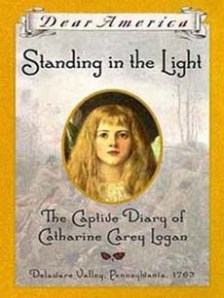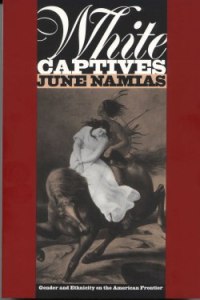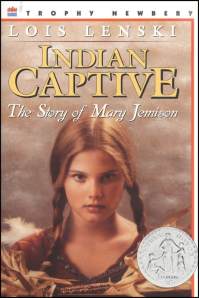Yesterday I wrote about the five Boyd children who were brutally captured by Iroquois warriors in 1756.
If that sounds terrifying, it probably was. At least it started out that way.
The Boyd children were taken by force, their mother and youngest brother killed because they couldn’t keep up.
The children were with their captors for seven years. Then the frontier wars were settled. Treaties were signed stipulating that all captives be returned. Colonial troops went into the wilderness to rescue them, returning with hundreds at a time.
But several of the Boyd children fought against returning home.
When they were forced under guard to reunite with their European-American families, these children managed to escape, and returned to the communities of their captors.
My blog post yesterday was a story of events, not explanations. 
Now I’m wondering about the explanations.
Why did not just these children, but so many others, and adult women and occasionally men as well, choose to stay with their Native captors?
Was it Stockholm Syndrome, wherein a captive irrationally identifies with her captor and blames her own people for not rescuing her?
Or was it something else, something the European Colonials did not want to even think about, that the Natives actually had the more desirable way of living?
If you’re expecting a definitive answer to that question, I can’t give it. I have only supposition, and some input from far more knowledgeable people than I.
 Captive-taking by Native Americans was surprisingly common in Colonial times.
Captive-taking by Native Americans was surprisingly common in Colonial times.
It was also common for captives to choose their Native communities over their Colonial families.
This puzzled the European Americans to no end.
They came to America believing that conversion would be easy once Natives saw the superiority of the Europeans’ religion, clothing, agriculture, dwellings, and every comfort known so far to man.
Yet there were very few Indians who converted to English culture, while large numbers of English chose to become Indian. Even Benjamin Franklin pondered why:
“When an Indian child has been brought up among us, taught our language and habituated to our customs, yet if he goes to see his relations and makes one Indian ramble with them, there is no persuading him ever to return. [But] when white persons of either sex have been taken prisoners young by the Indians, and lived a while among them, tho’ ransomed by their friends, and treated with all imaginable tenderness to prevail with them to stay among the English, yet in a short time they become disgusted with our manner of life, and the care and pains that are necessary to support it, and take the first good opportunity of escaping again into the woods, from whence there is no reclaiming them.”
One author put a bottom line on it in 1782, writing that,
“thousands of Europeans are Indians, and we have no examples of even one of those Aborigines having from choice become Europeans!”
Those are not the popular writers of their time, the serial novelists a nd journalists who sensationalized stories of captor brutality that today’s academics call “capture narratives.”
nd journalists who sensationalized stories of captor brutality that today’s academics call “capture narratives.”
These narratives were the thrillers of their time, and the public ate them up.
I have no doubt of much of their truth, aside from the sensationalism. A few were written as eye-witness captive accounts, after all.
Yet James Axtell, historian at Sarah Lawrence College, writes in the William and Mary Quarterly that the Natives treated their captives as equals nearly from the beginning of their captivity.
He notes that though food on the trail was scarce, it was shared equally with the captives. The children were given soft moccasins for running, lessons in survival, snow shoes for easier travel.
 Once in the villages, the captives were given Indian clothes, taught Indian songs and dances, and welcomed as family members into specifically appointed adoptive families.
Once in the villages, the captives were given Indian clothes, taught Indian songs and dances, and welcomed as family members into specifically appointed adoptive families.
It wasn’t necessarily easy. There were often rituals and trials that had to be passed, such as a gauntlet to beat the whiteness out of them, and afterwards, a second ritual to wash it out.
But once these trials were passed, captives were awarded full integration into the tribe.
Compared to the stern and rigorous life of a New England Puritan, or the hardscrabble life of a pioneer farmer, this life might have seemed more compassionate and civilized. The English were new here, still trying to tame the wilderness, bring it to its knees before the saw and the plow, to furrow its land and regiment its growth, much as it did its children.
I can see where life would definitely be more difficult for a European-American child of that time.
Most of the thousands of “white Indians” left no explanation as to why they chose their adopted Native families and culture over the Colonials. They just traded in their hard shoes and disappeared into the wilderness.
The only narratives we have are from those who chose to return to Colonial society. In those writings, it is clear that the “white Indians” valued what Axtell calls the Natives’
“strong sense of community, abundant love, and uncommon integrity – values that the English colonists also honored, if less successfully.”
 Axtell also notes other values, such as:
Axtell also notes other values, such as:
“social equality, mobility, adventure, and, as two adult converts acknowledged, ‘the most perfect freedom, the ease of living, [and] the absence of those cares and corroding solicitudes which so often prevail with us.”
As I said, I’m no expert. I’ve read only a few academic papers, not even enough to make me dangerous.
But if what these academic researchers say is true – and I have no reason to doubt them – isn’t it a shame that the imposition of culture was so one-way? Isn’t it a tragedy that the annihilation so complete?
We lost a whole culture. But what did we also lose in not heeding the lessons of our own children who chose to have different families?

I enjoyed this blog and have also ready captivity narratives in which the European-Americans preferred to stay with their Native “captors.” However, it should be said that there were also many, MANY, Caucasian women who were traumatized by the ordeal. Not to mention all of the abductees who were murdered by the Natives.
This is a difficult topic for many reasons. Obviously there were reasons that the abductions took place. White settlers encroached on Native territory and pushed them out. And, especially as time went on and we get into to Westward expansion, the US Gov perpetrated terrible atrocities against the Native Americans.
However, there has also been a white-washing (no pun intended) of Native American history in recent years as a knee-jerk reaction to the many years of vilifying them in popular media. If we’re taking an HONEST look at both cultures, there are pros and cons of both, and lets not forget that there were MANY different Indian nations and tribes whose practices varied widely. Even the abductions where captives grew to love their captors were undertaken with violence and murder. And, no one who discusses these captives ever seems to mention Stockholm syndrome!
Anyway, this is not a critique by any means. I’m currently writing an article on Mary Jemison, who is one of those captives who chose to live with the Natives until her old age and loved her adopted Seneca family as if they were her own. Yet, she seems to never have gotten over the murder of her family (who would?). And when researching captivity narratives, you find that for every captive who preferred Native life, there were about 5 who were totally traumatized by the ordeal. Reading some of these accounts will make your blood curdle…
Thanks for your note, Carolyn. I agree with much of what you say, but would be careful about qualifying the entire abductee experience by captivity narratives. As mentioned, for the most part only those who preferred to come home wrote narratives, which skews the sample.
NICE ESSAY
Hello, I am a decent any of such an individual doing some research of my own on this topic. Would you be willing to send me your earlier posts/references? Thanks. I look forward to learning so much more!
Pingback: American Indian rock opera shines unflattering light on Calif. pioneer
My third great grandmother Pricilla Perkins was captured by Indians late 1700s to early 1800s , actual the indian tribe that massicured her family did not see Pricilla, she was hiding in the wheat field. Shawnees found her, She married Tenskwatawa, brother of Techumsah and had Marcia Dec 25 1814. When the government required the Indians to give up their white captives, Pricilla married one of the soldiers a Lt Cobb, Marcia was adopted by the Bates family and later married Orrin B Cummings.
Supposedly there is a book with Pricillas Perkins story in it. I have not been able to locate it.
My paternal grandmother was a Perkins and always claimed she was related to Pocahontas, but we thought it was a joke. I was in my mid 30s before I saw a photo of her father Benjamin Perkins and thought he looked more African than Indian. A search of colonial court records explained the connections. The Perkins were listed as “mulatto” and a tax assessed for each member of the family. They went to court in protest claiming to be of Lumbee Indian and Spanish descent. Many neighbors testified to this fact. It was at this time that the term “Portuguese” was coined to classify this group of Indian-Spaniards. Of particular interest is that the Spaniard of the Iberian Peninsula were of African descent.
It was a Steve Martin moment when this fair-skinned white girl learned she had been born a poor black child.
Pingback: Paulette Jiles: News of the World (2016) – buchpost
Just doing a bit of research here for a book club. One question IO can’t seem to answer is:Why would various tribes want to capture an English child?
Usually it was a result of ‘mourning war’. If a Native American family lost a member in battle, either with white settlers or another tribe, it was custom to kidnap a member of that group to replace the family member that was lost.
whites brought native americans disease and decimated their numbers. possibly they captured whites to increase their numbers. according to books by Lousie Erdrich, a native american author, in their culture, if a child was killed (even by accident) the offending party had to give over one of their own children to compensate. read LA ROSE, a terrific book
The “Indians” refused to kill a baby or a child. They simply brought them back to their home, and raised them as their own.
Are you high ? There are hundreds if not thousands of instances Indians killing young captives for a variety of reasons. Conversely there were thousands Indian children killed by smallpox etc. Adoption into the tribe did occur frequently but if the kid could not keep up during the trip back to the tribes current location or was sickly or cried it was dispatched immediately. Sometimes cannibalized.
Pingback: 10 Pioneer Children Abducted By Native Americans Who Refused To Go Home | Friday News
Pingback: TIL: Ben Franklin wrote about Native American Indians, captured and raised from a young age by colonists, would return to their tribes after a single conversation with them. And that whites captured and raised within American Indian culture would flee the
Pingback: Quick Fact: TIL: Ben Franklin wrote about Native American Indians, captured and... - Quick Facts
There is something called a death primal that may occur when a child or person experiences something too traumatic to process. The event isn’t remembered and life goes on as if it hadn’t happened although physical symptoms of injury may continue to plague. I wonder if this explains anything?
And I just watched a TED talk with Dolph Lundgren regarding the psychological effects of physical trauma to children, related to his physical abuse as a child and how it affected him as an adult.
Kids adapt when they have no other choice.
The emotional trauma of seeing parents and siblings murdered spills into these children someway, somehow, someday. Such trauma may be frozen but it is there.
In some parts of New England, there are still some houses still left from colonial times, mostly in rural areas. Very many of these houses have secret compartments, hard to find, where children would or could be hidden in case of a possible Indian raid. I knew 3 houses like this in Woodstock Connecticut. They were usually below the floorboards; they could be surprisingly hard to find if you didn’t know the house.